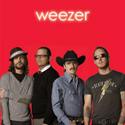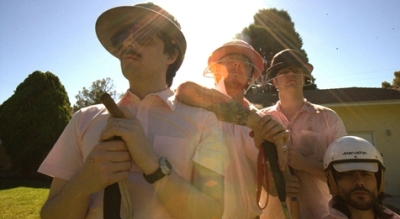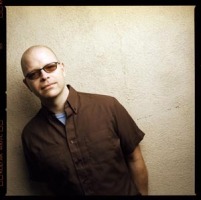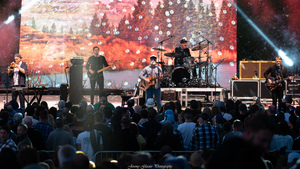
The Greatest Man That Ever Lived
An Interview with Pat Wilson of Weezer
Gail Worley
There was a stretch of about fifteen months in my not-too-distant past, say from late October of 2002 to February of 2004, during which I basically dropped out of productive society, declined to work a “day job” and instead sought to prove I could support myself (insert laugh track here) by freelancing for shitty rock publications, dating guys who could afford to buy me dinner, and selling everything I owned on eBay. I now euphemistically refer to those fifteen or so months as “back when I was unemployed.” It was not what I would call one of the more “enjoyable” times of my life – because, honestly, being poor and having to pay for your own health insurance really sucks. But it did afford me the opportunity to immerse myself in a few carefree experiences that I would have otherwise missed out on if I’d been overly concerned with facing my adult responsibilities and making a real living.

I can imagine you’re reading this and thinking, “Gail, this is a fascinating story and everything, but what does your Dark Night of the Soul have to do with the beloved rock band Weezer – the one that makes all of those unbelievably clever and hilarious music videos?” I’m getting to that. It was during my phase of being a forty-something slacker that I was invited by a respected journalist peer of mine, John D. Luerssen, to read his soon-to-be published book and to write a “cover blurb” for said book. The book, Rivers’ Edge, was John’s meticulously researched, unauthorized biography of Weezer’s lead singer/guitarist/founder/brain trust, Rivers Cuomo. Now, at this juncture of my life I was listening to a lot of death metal, and Weezer was not exactly my bag. But I really liked John’s writing and wanted to have a blurb written by me on the cover of his book. Plus it’s not like I was doing anything else worthwhile, so I agreed.
Taking into account that I didn’t really know anything about Weezer, didn’t own any of their albums and knew exactly three of their songs when I read the book, I will say quite bluntly that Rivers’ Edge blew my fucking mind, turned me into a Weezer fan, and gave me a little crush on Rivers Cuomo for about two weeks after I read it. It’s really got everything: sex, drugs, rock and roll, freakishly eccentric behavior, self-righteous power trips, you name it. And if the part where Weezer’s two most devoted fans die tragically in a car crash doesn’t break your heart then, my friend, you have no heart to break. Rivers’ Edge is an amazing book.
Anyway, I had the chance last week to interview Weezer’s drummer, Pat Wilson, about the band’s fantastic new album, Weezer (aka The Red Album, because it has a red cover) and he turned out to be a very cool guy as well.
Regarding the John D. Luersson book, Rivers’ Edge, I know John interviewed just about everyone except Rivers, and he sort of painted a picture of Weezer being basically “The Rivers Cuomo Show” rather than a four-piece group where each member has equal creative input in the band. However, it really doesn’t sound like that’s the case from listening to your records. What’s the story? Is there much difference in how you approach the drum parts for a song that Rivers writes versus one that you write?
Whoever writes the song, obviously, should be satisfied, is how it works out. Maybe that’s where a rumor like that gets started. I think if you compared Rivers’ demos with what the band ultimately winds up doing, you’d have to draw the conclusion that the band has a pretty large influence on the overall sound. Not the least of that is the way the drums work. Personally, I never felt like it was “The Rivers Show” (laughs) because I was doing too much. So, too bad Rivers couldn’t have been interviewed for the book.
Like I said, the book is great, and even though it was a kind of a “warts and all” expose;, ultimately it was very flattering. Everybody loves a mad genius.
Yeah, I think so. I mean, I didn’t read it, because… it’s just about Rivers, right?
Well, it’s about Weezer. It’s a very complete history of the band and there’s a lot going on. But this is not a Rivers Cuomo interview…
I’m used to it (laughs).
The Red Album sounds like it was a very fun record to make.
It was pretty fun. But it was a struggle in some ways because we were kind of re-tooling how we approach music. From my perspective I just wanted to say, “Okay, well, here’s my time to tell everyone how I think things should be.” Most of it had to do with how the drums are captured. Of course, we don’t Protool anything. It’s important to me that if it sounds good to my ears while I’m playing the drums then that’s what I want to hear [on the finished recording]. I get frustrated, actually when the engineer says, “You’ve got to do it this way because later on it’s going to hold up in the mix really well.” I don’t want to know about later on, I want to know about now. I don’t like the idea of a mix drastically changing what we were doing. I like what we were doing, and I think in that sense this CD is kind of “old school.”
Yeah, you’ve talked in other interviews about playing “what you hear” as far as staying true to the way the drums are captured in the studio, getting the desired sound in the recording process and forgetting about “fixing it in the mix.”
Oh, I hate that. It frustrates the shit out of me. I hate not knowing what it’s going to sound like. For me, if you put four mics on a kit, that’s the drum sound. I’ll tell you honestly, my favorite recording of all time is
Highway to Hell by AC/DC. I feel like that recording isn’t anything other than what they did [in the studio] at the time. But the way records are made today, I think that the grid has taken the drummer out of the band. You might as well not even have a drummer, if you really start chopping stuff up. It’s like, “well, why don’t you just use samples?” Believe it or not, people are making records without drummers, just using BFD (drum software). Personally, it’s not something I like listening to.
It reminds me of how prevalent drum machines were in the ’80s, and producers got their perfect-feeling time, but there was no real feel in the track because a real drummer wouldn’t play like that. It was sort of an accepted phenomenon. I wonder if that practice set “real drumming” back at all.
Well, that’s true but ironically, or maybe not ironically, it seemed to suit a lot of that music. For me the ’80s was where Goth and just kind of “sad music” started. That kind of hollow feel and hollow sound of the song was, I think, perfectly complimented by that rigid, robotic drum track. But I’m with you. I like to hear [a real player]. If a drummer can have a feel, to me, that’s what moves the music along.
On the new CD, I have to admit there were a couple of places – a couple of songs – where you captured what I felt was a total John Bonham feel, specifically the intro to “Everybody Get Dangerous,” which sounds like “The Immigrant Song,” and “Cold Dark World.” I got a little thrill from that. Is that what you were going for?
Well, first, thank you so much for comparing me to John Bonham, because he’s my favorite drummer. I think that there are two things that mark his sound. One is the atmosphere of the drums, like the sound around the drums – thinking of the kit as one thing rather than eight things that each gets a mic. The other thing is that he’s laid back; he’s laid back in the cut. That’s my feel, naturally, to be behind the beat. I just happen to enjoy what drums actually sound like in a room when you put up a couple of mics. To me, nothing sounds better than that, so I’m pleased that that came through on the track.
Yeah, it really did and I loved it. You just don’t hear drummers getting those huge sounds and natural tones anymore, not in pop music anyway.
Well, here’s what happened. I have this conversation with engineers all the time. A drummer comes in and says, “I want it to sound like ‘When the Levee Breaks.’“And the engineer always says, “Really? Okay, here’s what I’m going to do…” and he throws up a couple of mics and the drummer plays and it sounds like shit (laughs). “Why doesn’t it sound like ‘When the Levee Breaks’? And the engineer says, “Because you don’t play like John Bonham!”
That’s excellent.
It’s true! It happens all the time. “You want sound like James Brown? Okay!”
Speaking of Bonham, are you still playing the Ludwig Vistalites?
I’ve always played Ludwig. Right now I’m playing a Ludwig Legacy Classic, which is kind of like a return to the older style with the reinforced hoops and all that. It’s just a classic sound. I didn’t get rid of the Vistalites, I just get tired of stuff and I want a new drums. In fact, I played the Vistalite kit on the song “Automatic.” That’s my song that I wrote and it’s a completely un-muffled Vistalite kit.
For “Automatic,” did you feel like you had more freedom to do whatever you wanted with the drums since you wrote the song?
I didn’t feel like, “Oh, here’s my chance to do some crazy drum stuff!” But it was me thinking how I would play drums on my song. That song sort of got started as a drum beat, actually; I played that drumbeat and that was the spark of the song. Maybe I should have actually thought, “Oh, I’ll have a drum solo in here.”(Laughs) I’m waiting for a band to come out and actually play a drum solo in concert again. I might have to do it myself!
I think you should!
It will give people a chance to go get concessions (laughs). I want to do a drum solo!
Has your kit changed much over the years, as far as changing sizes or stripping it down?
Yeah. I started with a 22 (inch kick) but it was kind of a long kick drum and, as time goes on, I realize that there are only two kinds of kick drums that I like. One is a 22 x 16 and the other is a 26 x 14. For me, a 24-inch kick drum is neither here nor there, and some 20s can be cool, but mostly I’m into 22s and 26s. Although I do have an 18 that I like to mess around with if I’m trying to get that kind of cocktail vibe. But like I said, the type of sounds I’m into are where I can put three microphones up that would be the kit.
How big is the kit that you’re playing now?

It’s pretty much always a four-piece: kick, snare, rack, and floor, a couple of cymbals and a ride. I could probably do with less. I have the extra crash. I actually get myself into trouble. When I get bored on tour is when the extra drums start coming out and then everything just goes south. I’ve been getting into Bill Stewart, the guy who plays drums with (jazz guitarist) John Scofield. He’s such a good drummer. I saw him doing that Blue Note thing with Scofield and it really blew my mind. It was like some kind of bizarre mix of be-bop and weird New Orleans jazz. And it’s all just so effortless.
Speaking of effortless, you know what my favorite memory of your playing is? It’s from the video for “Undone, the Sweater Song” where you get up and run around your drums kind of in slow motion, but you’re still playing them. I love that.
That’s funny! Yeah, we tried to just make things… happen in a fun way that day. That was a long time ago…
Yeah, you’ve been in this band for sixteen years! Is there any challenge to keeping things fresh after being in the same band for so long, or has it just naturally evolved to keep things interesting for you?
I think there came a point on the last record where, even though “Beverly Hills” was real successful and all that, and the songs were good, it just felt like the process was a little stale. On this record we really challenged ourselves to break out of the old way. People are playing all kinds of different instruments on this thing. I play some synthesizer and I play lead guitar on a couple of tracks, and I sing lead on one song. In the process, that just made the difference. We just felt like we had to “grow the band,” that we couldn’t do the same thing over and over.
But what’s cool is that even though you guys don’t sound stale, you continue to sound really clever and fresh and surprise your fans, but you also still sound like Weezer. It’s not like Weezer is trying to be Marilyn Manson or whatever.
I’m glad that it comes across that way because that’s exactly what we were hoping to do: keep what was cool and build on it rather than go listen to a bunch of Prince records and [try to sound like him].
The new band bio has a quote from you that explains you were “trying to get more open with sounds [and] not quite so close and dense.” Were you talking about overall sounds or drums sounds?
Overall, really, but mostly for me it would be about the drums. I don’t know if it’s because I’m just getting older but I find that I’m listening to music from the late fifties and early sixties and I’m saying to myself, “Wow, nothing really sounds better than that.” I’m trying to figure out how they went about what they did, and it was a lot simpler than what people do today. Most of today’s recording techniques are designed around protecting against the flaws of the band, whether it’s cutting to the grid or using insane amounts of compression or auto-tune or whatever. These are tools that are designed to minimize flaws rather than maximize what was happening [in the studio]. Ideally – and I told these guys, too – I would rather take the $100,000 challenge. We just threw up a bunch of mics and went straight to two-track and that was the take. “It’ll be just like ‘Hound Dog’!” I think that’s where the energy comes from.
The more you try and edit the energy into something, I think the less energy you wind up with. If Protools had been around when Elvis was here? You wouldn’t have gotten anything good (laughs). Or how about Zeppelin? Zeppelin wouldn’t even make it today. It’s bad. If a band is on fire, then it’s just on fire. Led Zeppelin was good because that’s just what they sounded like. I’m sure that Jimmy Page did a lot of funny shit in the studio but for the most part, [how they sound on the record] is how they are. They’re just a rock band. If you’re good…it’s like (the Miles Davis’ record) Kind of Blue. If you put Kind of Blue on, it’s like, that’s what happened that day! It’s brilliant.
I really do love the drum sounds you got on this CD, which are very big and fat but on the dry side. Was that your objective for the sounds you wanted, and how did you achieve them?
Really, there are two drum kits on the record. One was used on three songs: “Angel and The One,” “Dangerous” and… I can’t remember the other one, but that was more of a close-mic’d, modern sound that they could squeeze to get the atmosphere out of the close mic. The rest of the record was pretty much a kick, snare, and a pair [of toms], and maybe a room mic to get more of the atmospheric sound of the drums. It’s funny, because at the time I was such an evangelist for the older school technique of fewer mics and more air, but I have to say that the songs that have the close mics on them do sound good too.
Did you do anything like putting towels on the drumheads?
I’ll tell you what I did: I’ll give away a secret to the record that nobody will ever do. On the songs that were big rock songs that needed an open sound, a common problem is that you can hit the crash cymbals quieter and pump up the room mics or you can use quiet cymbals. Some of the songs have crash cymbals with no bell. I would use a flat ride with no bell and it’s just comical how you can hit one of those cymbals and they don’t make any sound. You can just wind up and lay into a flat ride and it just goes “shoosh.” So, that was the secret to some of the bigger room sounds.
How was this CD more experimental than previous Weezer records?
The obvious thing would be that there are singers and songwriters other than Rivers on the record. Each of us other guys has one song on there. Some of the instrumentation, I think, is a little bit different. Like I said, Scott was playing a Poly Evolver (keyboard) on one song and we had the Moog on a couple of tracks. There are a couple of songs like “Greatest Man” and “Dreaming” where the arrangements are untraditional, to say the least. Compared to our other records I would say it’s definitely got way more “out there” stuff. I never liked the term “experimental.” It sounds like you’re saying, “Well, if it fails it was just an experiment!” I don’t really look at it as an experiment as much as, like, [it being just] crazy.
How did the parts for “The Greatest Man That Ever Lived” evolve?
That song is a theme in variations, so each section was modeled on a band or a singer or some sort of artist. For me, I didn’t really play that different. I just played the drums how I felt was appropriate musically. The marching snare in what we call the chorale section, which is where we’re all singing with the snare drum underneath it, I really had to fight to get that in there. At the last minute that whole section was going to be edited out of the song and I was like, “No, no, no! It’s key; you’ve got to have that part!” I remember sitting there in the mastering room actually inserting my snare drum back into the master. I was like, “you’ve got to have it – it’s all about that.” I felt like I had to be the thread that looped it all together.
You don’t hear many, or any, modern pop songs that have multiple, epic sections like that any more.
Yeah, you don’t really hear modern pop songs that do anything different these days. I mean, if it doesn’t sound like Hannah Montana, you got nothin’. Something really has changed. Maybe to someone who grew up on Glen Miller, Led Zeppelin doesn’t sound like anything, but from my perspective I really believe that music has changed and not always for the best.
Do you have a favorite drum or a part of your kit that you feel is “the center of your sound” or something like that?
I can tell you the drum that frustrates me the most, and that’s the snare drum, because what I hear in the distance from the drum to my ear, that’s what I like to hear because I’m like a feedback loop and the way it sounds at my ear is the way I think the drum sounds. But then someone will throw up a bottom snare mic live and have that loud and I’ll be like, “That sounds awful, dude. That sounds like Gary Glitter or something. Stop it. It sounds like Led Zeppelin where I’m from but you’re making it sound like Duran Duran.” (Laughs) You know, I shouldn’t even say Duran Duran because I actually love them. But… it’s funny what you said earlier about the eighties, because that was one of the few bands in the eighties that actually had a live drummer. I love the drums on those records; they’re pretty good!
Weezer: http://www.weezer.com ◼












